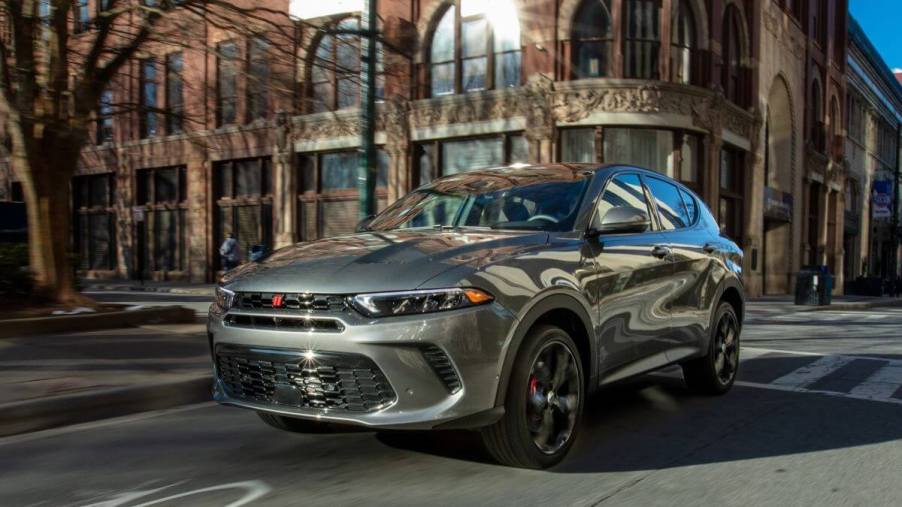
The 2024 Dodge Hornet GT Continues the Brand’s Power Attitude
The Dodge Hornet is a harbinger of change for the American automaker. The Hornet paves Dodge’s entry into the compact SUV class, or any “compact” segment for that matter. Under the attractive bodywork of the Hornet resides a four-cylinder, plug-in hybrid electric powertrain, effectively the antithesis of the brand’s focus on brawny, fuel-guzzling V8s.
As such, the Hornet is an outlier to what we’ve come to expect from the brand. But getting behind the wheel of the Hornet shows the Dodge mission of providing far more performance than necessary is still alive and well.
Dodge’s historic focus on prodigious power
Dodge hasn’t been content just to sell its full-sized Charger sedan for family hauling and commuting duties. Sure, you can have one with just 300 horsepower, but you can triple that with the Hellcat Redeye. The Charger Hellcat Redeye’s 797 horsepower is so prodigious even a small stab to the throttle can turn its rear rubber into atmosphere.
It’s the kind of unrestrained muscle that requires drivers to gently massage the throttle in a roundabout lest the car use a dab of acceleration and a bit of turning as an excuse to swing out its backside in an uncontrolled drift.
I’ve tested hundreds of new cars over the past five years, and to this day, the only time I’ve been ticketed for speeding—that is to say, “caught”—was behind the wheel of the Dodge Durango Hellcat.
Driving a three-row SUV gives you an expectation it won’t be particularly quick. Of course, it’s a performance Dodge, so the Durango Hellcat cranks out 710 horsepower and a heavy-duty truck’s worth of torque, so its obliterates speed limits with ease while hauling the whole family.
Dodge’s products, along with its marketing efforts, suggest only those who need a wheelbarrow to transport their cojones should drive their models. While the Hornet won’t blow the doors off much at the drag strip, it certainly continues that M.O.
The 2024 Dodge Hornet packs a hefty punch for its class
The 2024 Dodge Hornet is available in two guises, GT and R/T. The R/T shares much of its underpinnings with the Alfa Romeo Tonale—another Stellantis product—with up to 288 horsepower and 383 pound-feet of torque from a PHEV drivetrain. Even the “lowly” GT model, which I tested, dishes out 268 horsepower and 295 pound-feet of torque with a turbocharged, non-hybrid four-cylinder.
While the 2024 Hornet GT’s power figures pale in comparison to some of its Dodge stablemates, it’s crucial to remember the Hornet is up against the likes of the Honda CR-V, the Toyota RAV4, the Hyundai Tucson and the Ford Bronco Sport, all of which deliver around 200 horsepower in their base guises. Even the most powerful Bronco Sport is at a 23-horsepower disadvantage to the Hornet GT.
As such, the Hornet can wear the badge of “most powerful” in its class, just like the Durango and now-defunct V8-powered Charger. Still, the Hornet won’t rip your head off with a surfeit of power, but it does instill quite a bit of excitement into a fairly dull segment.
Dodge Hornet GT driving dynamics
Dodge claims the GT, with its nine-speed automatic transmission, will zip from 0-60 mph in 6.5 seconds and on to a top speed of 140 mph in a class where the former figure is admirable and the latter doesn’t really matter to the competition. As such, the Hornet is far livelier from behind the wheel than a traditional compact SUV.
Acceleration isn’t mind-blowing off the line, but once the turbo spools a bit this little Dodge delivers a punch that can throw your noggin into the headrests while you feel a touch of easily controlled torque steer. After throttle tip-in, the Hurricane turbo four delivers plenty of pep throughout the rev range. You won’t be late to soccer practice if you let it rip.
But thanks to a sporty suspension, appropriately hefting steering, and solid brake performance, the Hornet’s strengths go beyond outright power—it can be properly fun on twisty tarmac. And unlike its Hellcat brethren, it can carve corners without forcing you to change your underwear afterwards. Its agility and outright power are more than what’s standard for the class, but still well within reason.
There aren’t many compact SUVs that can be placed in the “fun-to-drive” category, but the Hornet lands squarely in that camp. And when you’re cruising, ride comfort is respectable comfortable over road imperfections despite the suspension’s sporty setup.
The Hornet’s non-performance characteristics
Despite its ample grunt, the 2024 Hornet GT starts at around $30,735, putting it on par with many of its competitors. It’s not all go and no show, either. The base model still sports 17-inch wheels, all-wheel drive with torque-vectoring, cloth/leatherette seats, a 10.25-inch touchscreen, digital gauge cluster and a suite of driver aids.
The GT Plus model adds to the amenities with a sunroof, power liftgate, heated/ventilated front seats, navigation, a Harman Kardon sound system and more.
The Hornet does require a sacrifice in pragmaticism as its rear seats are slightly cramped even for its class. But if you have your heart set on having the most powerful mainstream compact SUV on the market, you can argue its smaller stature aids its agility. Cargo space is respectable at 27 cubic feet behind the rear row, though the center console and door cubbies aren’t exactly spacious.
Ultimately, the Hornet GT is one of the more endearing compact SUVs for those who like to regularly plant their foot down on the noisy pedal. Yet, it’s not a one-trick pony. It’s well-equipped, comes with an agreeable price, offers decent pragmaticism, and with its aggressive styling and boisterous-for-a-four-banger exhaust, it’s a smart choice for those who want to break away from the doldrums of the small SUV class.



